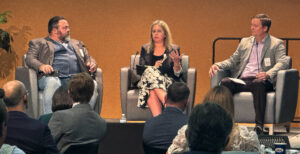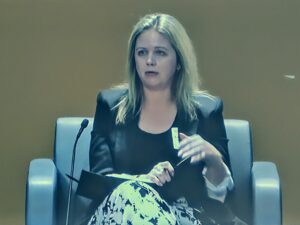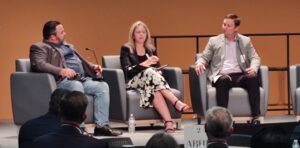 The opening panel of our 2025 QPD Symposium tackled one of the most pressing challenges facing communities across the region: how to respond to rapid growth. The session provided a comparative look at how different cities have approached the demands of expansion, the infrastructure pressures that come with it, and the policy tools needed to build sustainable, thriving communities.
The opening panel of our 2025 QPD Symposium tackled one of the most pressing challenges facing communities across the region: how to respond to rapid growth. The session provided a comparative look at how different cities have approached the demands of expansion, the infrastructure pressures that come with it, and the policy tools needed to build sustainable, thriving communities.
Moderated by Matt Stoops, Vice President of Planning at LJA Engineering and Vice Chair of WHA’s QPD Committee, the panel featured insights from two seasoned municipal professionals: Lauren Fehr, Senior Planner at BGE and formerly with the City of Sugar Land, and Kris Carpenter, Planning Director for the City of League City.
Their conversation started with a simple but foundational question: what does successful growth look like? Carpenter emphasized that growth management is never a one-size-fits-all solution. “What works in League City may not work in Sugar Land or Houston,” he noted. Instead, he stressed the importance of a community-driven vision that reflects local values and needs. In League City’s case, this has meant leveraging natural features like Clear Creek and Dickinson Bayou as community assets, not development obstacles, as the city expands on its southwest side.
Fehr offered a different perspective, rooted in the lifecycle of the city of Sugar Land, which started experiencing its major population growth in the 1970s through the 1990s, and has now shifted its focus to redevelopment and reinvestment. She credited the city’s long-standing success to its early adoption of comprehensive plans, strong zoning, and policy alignment across departments and elected leadership. More recently, she explained, the city has positioned itself to take a more active role in shaping future growth, citing land acquisition in the old Imperial Sugar Company area as an example of how the public sector can “drive the bus” when it comes to redevelopment.
As cities grow, infrastructure is typically the first system to show signs of stress. Water, sewer, drainage, transportation, and even power all require coordinated planning to keep up with demand. Carpenter shared League City’s experience with a transformative infrastructure agreement known as “The Grand Bargain.” With little utility infrastructure available in the city’s undeveloped southwest quadrant, the city partnered with a developer to extend water and sewer trunk lines from an existing treatment facility. The developer provided the upfront capital, while the city paid to oversize the infrastructure in anticipation of future growth. The project unlocked significant development capacity in an area that previously lacked basic services.

Fehr echoed the importance of regional public-private partnerships in overcoming infrastructure challenges. In Sugar Land, the city’s ability to rely on policy-driven tools, such as water, wastewater, and drainage master plans, has been essential, particularly since it does not utilize municipal utility districts (MUDs) within city limits. She pointed to an effort south of the Brazos River where a homebuilder, guided by city plans, acquired land for a 900-acre residential development including land for future water and wastewater treatment plants. Without utilizing a regional approach to utilities, she explained, the area would have remained undevelopable.
Both panelists emphasized the increasing need for regional coordination. Carpenter spoke about League City’s work with adjacent municipalities and regional planning organizations like H-GAC to align transportation and drainage systems across jurisdictional lines. He also identified an area of improvement: coordination with power utilities. Cities often lack visibility into power providers’ long-term planning, and developers are typically left to negotiate power service independently. Carpenter argued for a more integrated approach to ensure that electric infrastructure can support future growth.
Fehr added that regionalism will only grow in importance. With Sugar Land nearly built out, the city’s planning efforts turned toward its extraterritorial jurisdiction. Long-term forecasts showed that only a regional solution to infrastructure—particularly water and wastewater—could make development in that area viable. Thanks to staff alignment and leadership buy-in, the city was able to secure a partnership with a builder who brought land and capital to the table, paving the way for substantial growth in the years ahead.
As the conversation turned to regulatory frameworks, both panelists acknowledged that overly rigid systems can become barriers to smart growth. Carpenter recalled League City’s experience in the early 2000s when its newly adopted zoning code resulted in a high volume of variance requests—sometimes eight to ten per month. Recognizing the pattern, the city rewrote much of the ordinance, significantly reducing the need for variances and creating a more flexible, responsive code. Today, League City receives only two or three variance requests per year.
Fehr emphasized the need to engage the development community when undertaking regulatory reform. She advised cities to treat repeated variance requests not as routine, but as red flags, and to consult with builders, brokers, and contractors about where the pain points are. “Not everyone will agree,” she said, “but if you’re not talking to developers, you’re already behind.” Particularly in redevelopment contexts, cities need to stay nimble and rethink their rules to reflect changing land use and market dynamics.
 To improve internal development review, both cities have invested in process innovation. Carpenter detailed League City’s Development Services Strategic Plan and its internal Elevate Academy program, which encourages staff to propose and implement process improvements. Recent changes include digitizing submittals, automating workflows, and requiring applicants to meet with city staff if projects reach a third review cycle. The goal, Carpenter explained, is to resolve issues quickly and limit delays.
To improve internal development review, both cities have invested in process innovation. Carpenter detailed League City’s Development Services Strategic Plan and its internal Elevate Academy program, which encourages staff to propose and implement process improvements. Recent changes include digitizing submittals, automating workflows, and requiring applicants to meet with city staff if projects reach a third review cycle. The goal, Carpenter explained, is to resolve issues quickly and limit delays.
Fehr described Sugar Land’s implementation of a new plan review system, which was developed in partnership with local stakeholders. The city hosted roundtable sessions with developers, trades, and inspectors to understand where the friction was in the review process. The result was a more transparent, efficient workflow that shortened timelines and improved coordination. Educating city staff about the downstream impacts of delays, such as increased housing costs or market withdrawal, was also a key part of the effort.
No conversation about growth is complete without addressing public engagement. Both panelists recognized that new development often sparks concern from residents, especially around issues like traffic, drainage, and property values. But if handled well, those concerns can become opportunities to build trust.
Carpenter shared how League City recently completed a development plan for its southwest side, involving council members, planning commissioners, property owners, and residents from the start. The city used town halls, surveys, and social media to gather feedback. “You’ll get plenty of criticism on Facebook,” he noted, “but those same people rarely show up to the public meetings.” Still, he stressed that outreach, no matter the format, is essential to building understanding.
Fehr acknowledged the emotional weight that often accompanies growth discussions. Residents worry about taxes, traffic, safety, and quality of life. Drawing connections between proposed developments and tangible benefits, like improved roads or expanded drainage capacity, can help ground the conversation. She encouraged cities to identify community advocates who can bring others to the table and translate technical details into personal relevance.
The panel closed with a call to action. Carpenter urged communities to plan ahead of the curve, not after the fact. “Start your planning efforts early,” he said, “and build relationships—with residents, with developers, with everyone involved in shaping your community.” Fehr agreed, emphasizing that proactive policy, regional collaboration, and strong leadership are critical to ensuring sustainable growth. “Be collaborative, not combative,” she said. “Break out of your silos and think long term.”
As West Houston and the broader region continue to absorb significant population and job growth, this panel reminded attendees that the quality of our future will depend on the decisions we make today. Planning, coordination, and partnership aren’t just best practices—they’re essential strategies for turning growth into opportunity.
